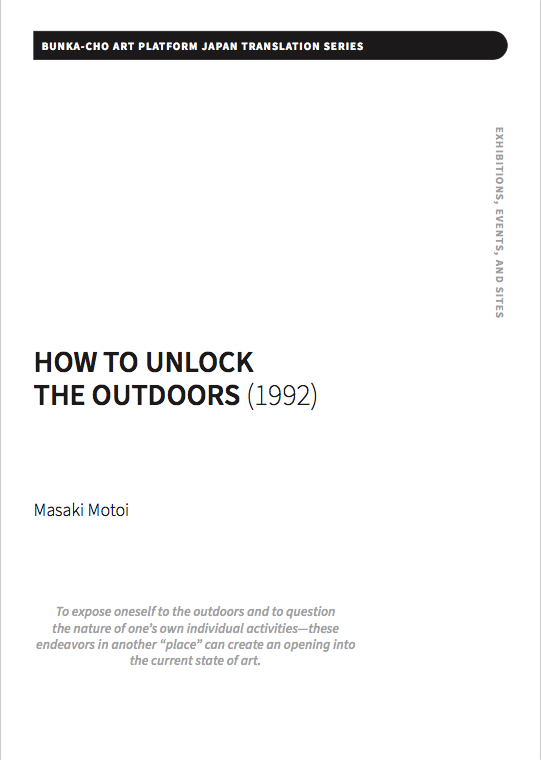How to Unlock the Outdoors
Masaki Motoi
R202114

In this article, Meguro Museum of Art curator Masaki Motoi (b. 1951) writes about the historical background of the outdoor art exhibitions that have taken place throughout Japan.
The pioneering attempts of the Gutai Art Association and the Kyūshū-ha originated in a skepticism toward the art system and a desire to intervene in daily life. In the 1960s, outdoor art exhibitions were spearheaded by the government and premised on the notion of achieving harmony with urban environments, such as public parks. During the 1970s and ’80s, artists began to hold independent outdoor art exhibitions as if attempting to escape this framework. Since the 1970s, there has been an increase in attempts to liberate artists and audiences who have felt a sense of confinement in art by moving away from urban spaces in favor of endlessly vast spaces and incorporating spatial relationships into artworks. At the same time, the ’70s also saw the reappearance of doubts regarding the art system and an expansion into the use of living spaces, such as artists’ own living spaces, as venues.
In recent years, the village has become the stage for not just outdoor art exhibitions, but also workshops and Butoh dance programs, and attempts have been made to facilitate festive communion between nature and place through works of art. Masaki highly values such outdoor exhibitions—which focus on the power of rural performing arts as a means of breaking away from a decaying urban art system—as an attempt to create another kind of contemporary art that is founded on a mistrust of the current art framework, imbued with the vitality of vernacular and folk customs, and different from the “contemporary art” of the present day. Following this, outdoor art exhibitions, also called art projects, began to flourish in Japan with such events as the Echigo-Tsumari Art Triennial, which commenced in 2000. This article represents an important discussion on the significance and historical context of outdoor art exhibition and has had an influence on later discussions of these art projects.
- Title
- How to Unlock the Outdoors
- Author
- Masaki Motoi
- First published
- 1992
- Translation
- Darryl Jingwen Wee
- Editing
- Naoki Matsuyama, Uesaki Sen
- Design
- Ian Lynam
- Theme
- Exhibitions, Events, and Sites
- First Posted Online
- 2022-04-28
- Last modified
- 2022-04-28
© 2021 Masaki Motoi + Bunka-cho Art Platform Japan
The newly published English translations on this website (https://artplatform.go.jp) can be used without permission only for the purposes of education, research, critique, survey, and the like. English translations cannot be copied for the purpose of sale or distribution. You must comply with the Rules Governing the Use of the English Translations.
- Citation
- Footnote/endnote: Masaki Motoi, "How to Unlock the Outdoors," trans. Darryl Jingwen Wee, Bunka-cho Art Platform Japan, posted April 28, 2022, artplatform.go.jp/readings/R202114.
Bibliography: Masaki Motoi. "How to Unlock the Outdoors." Translated by Darryl Jingwen Wee. Bunka-cho Art Platform Japan. Posted April 28, 2022. artplatform.go.jp/readings/R202114. - Original Japanese Edition
- Masaki Motoi "Ya o hiraku kagi" Bijutsu Techo, no. 661 (November 1992): 89–97.
正木基「野を開く鍵」『美術手帖』661号(1992年11月)、89–97頁。 - National Diet Library(NDL)
- https://id.ndl.go.jp/digimeta/7924216
- ISBN
